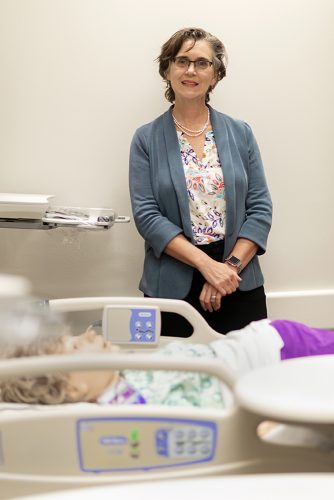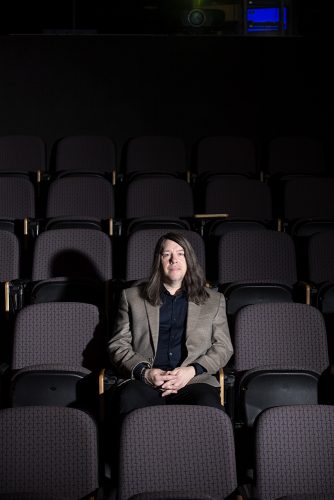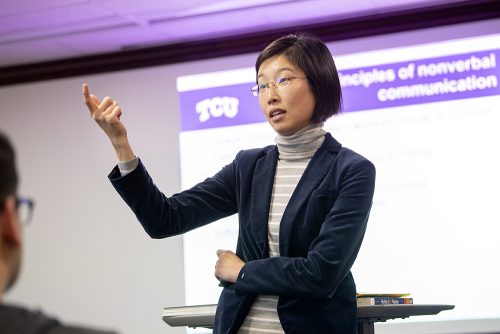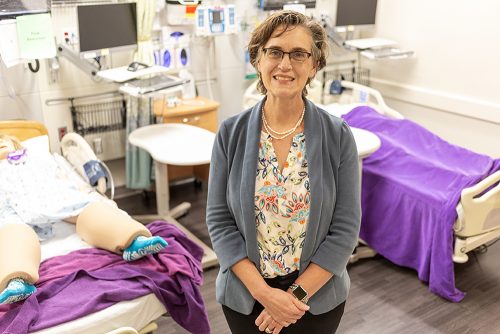Social Networks, Media Play a Powerful Role in Public Perception of Disease
TCU professors study media’s impact on effective messaging regarding illness and treatments.

RyanKing999 | iStock | Getty Images
Social Networks, Media Play a Powerful Role in Public Perception of Disease
TCU professors study media’s impact on effective messaging regarding illness and treatments.
Viral tweets about fake Covid-19 statistics or supposed cures.
Bland and all-too-familiar TV ads for prescription drugs.
Hollywood depictions of men living with AIDS that emphasize telltale lesions on the face.
Health communication seeps into society through various media and can play a powerful role in public perceptions of illness, disease and treatments. A new minor in health communication and media puts TCU on a path to capitalize on growing interest in the field, both for students who want to pursue medical or health care-adjacent professions and for faculty seeking to research a range of related topics.
Effective communication and empathy also stand at the heart of the curriculum of the TCU and UNTHSC School of Medicine, which welcomed its first class in July 2019.
Medical students work with artistic directors and communication professionals on role-playing and patient simulations. Physicians-in-training hone their listening skills while also learning the most effective ways to impart information with the purpose of improving patient interactions and care.
The medical school’s efforts dovetail with the growing body of research from faculty in TCU’s Bob Schieffer College of Communication. Their shared goal is to discover the best ways to educate people about the most beneficial options for their health.

Wendy Macias’s recent research has focused on health communication, including the efficacy of direct-to-consumer drug advertisements. Photo by Mark Graham
In fall 2020, Wendy Macias, associate professor of strategic communication and associate dean for undergraduate studies, taught the introductory foundations class for the health communication minor.
Students came from a range of disciplines, from engineering to nursing. Understanding how to impart health-related information most effectively, Macias said, has relevance to many both personally and professionally.
“There is so much misinformation,” she said, “particularly in social media.”
A report released in August 2020 by worldwide media watchdog group Avaaz indicated that global health misinformation received at least 3.8 billion Facebook views during the prior year. April 2020 — as the Covid-19 pandemic was escalating in the U.S. — saw a peak in misinformation, with an estimated 460 million views of erroneous posts.
“If Covid-19 has taught us anything,” Macias said, “it’s that all of our lives are at stake and that health care messages in the media matter.”
AIDS on Screen
The eruption of the coronavirus pandemic was not the first time in modern history that disease dominated public imagination.
A lack of hope in the fight against AIDS typified film depictions during the 1990s, mirroring the bleak realities of a disease much feared and little understood.
Later that decade, scientists created cocktails of pharmaceuticals that helped extend the lives of many living with HIV and AIDS. But for the general public, particularly in the early half of the ’90s, most of the information about the disease came through coverage in the news media or film.
“Most people could not have gotten that knowledge otherwise, which made those early images even more influential,” said Kylo-Patrick Hart, chair and professor of film, television and digital media.
In the award-winning 1993 movie Philadelphia — the first major Hollywood film focused on the AIDS crisis — a gay attorney, portrayed by Tom Hanks, sues his former employer for discrimination. The law firm had fired Hanks’ character when his illness became apparent.

Kylo-Patrick Hart researches LGBTQ issues in film and media studies. Photo by Jeffrey McWhorter
The progression of the protagonist’s disease, which ultimately leads to his on-camera death, is noted in part by the appearance of Kaposi’s sarcoma, or lesions, on the actor’s face.
“The [sarcoma] lesions represented a visual shorthand,” Hart said.
Hart’s chapter, titled “Representing AIDS: KS Lesions, U.S. Visual Culture and the Body as Canvas (1983-1993),” appears in The Body in History, Culture and the Arts, edited by Justyna Jajszczok and Aleksandra Musial and published by Routledge in March 2019. In the chapter, Hart argues that the lesions galvanized activists at the time.
“From the moment the lesion-centered imagery began to surface in U.S. society,” Hart wrote, “members of the gay community insisted that AIDS must be viewed as a disease and not a divine judgment.”
In 2020, Hart wondered about the degree to which representations of the Covid-19 pandemic will ultimately parallel the trends he has spent much of his career analyzing.
“That is one reason why learning something about the representation of AIDS in the media and how it contributed to social construction matters,” he said. “Because there will be other pandemics coming, and maybe for the next one we won’t blame the victims so easily.”
Countering Covid-19
In the wake of the coronavirus, Jie Zhuang, assistant professor of communication studies, paused her research on mainstream media coverage of live organ transplants to address the pandemic.
She looked at ways to motivate healthy Americans between 18 and 45 — those less likely in the early days of the pandemic to encounter deadly consequences from Covid-19 — to embrace protective measures such as face masks.
Zhuang turned to the crowdsourcing platform Amazon MTurk to measure participants’ perceived risk by asking them to rate the truthfulness of the statement “I am susceptible to Covid-19.” She also assessed their views concerning social norms of precautions by measuring responses to statements like “Many people around me wear face masks to prevent Covid-19.”

Jie Zhuang studies the relationship Americans between 18 and 45 have with Covid-19 precautions. Photo by Jeffrey McWhorter
Counterintuitively — and to her surprise — Zhuang discovered that when those surveyed felt threatened and personally vulnerable to Covid-19, their expressed intention to comply with social norms and adopt protective measures like wearing face masks remained the same or decreased.
Zhuang’s research also revealed that those who felt less threatened by the coronavirus tended to express a stronger motivation to fall in line with social norms and observe the safeguarding measures communicated by health professionals.
Those findings have relevance for anyone in academia or health care who is trying to craft effective messaging, she said.
“This research,” Zhuang said, “suggests that caution be practiced when social normative approaches are used in campaigns targeting young people, who are known to be susceptible to social normative influence.”
Social Network News
Zhuang’s colleague Qinghua Yang also focuses on strategic messaging by looking at how to motivate adults to improve their health.
“More researchers are paying attention to how we can use methods to persuade people to quit unhealthy behavior like smoking or substance abuse and how to adopt healthy behavior like physical activity and eating fresh vegetables,” said the assistant professor of communication studies.
Social media, Yang said, plays a key role in contemporary communication. Research from health care consulting firm ReferralMD indicates about 30 percent of adults share information about their health on social networking platforms.
Her 2018 paper published in the Journal of Health Communication focused on instances in which cardiovascular health-related tweets were shared on Twitter, with retweets serving as the metric to evaluate a post’s impact.

Qinghua Yang says she wants to better understand what makes a social media message effective. Photo by Glen E. Ellman
Yang and her co-authors from the University of Pennsylvania identified 1,251 relevant tweets posted between 2009 and 2015. They coded the tweets according to novelty, utility, theme and source. They examined how some users took to Twitter to ask questions, while others shared personal experiences. Some also tweeted recommendations for certain doctors or treatments.
The goal of the research, Yang said, was to gain a better understanding of what constitutes an effective message on a platform where users had only 140 characters to connect with others.
Social media has gained relevance for public health, the study contended, because “one-third of U.S. individuals are using social media to find health information, share their symptoms and offer options about doctors, drugs and treatments.”
Yang’s team concluded that users tended to share tweets that included certain linguistic features such as exclamation points and hashtags. Tweets coming from organizations were more likely to be retweeted than those posted by individuals.
“Nonhealth organizations could be perceived as less credible,” Yang said, “given that they are not related to health and may have self-interests involved in posting the tweets.”
Efficacy of Ads
Like Twitter, advertising is known for its efficiency: Ad agency creative teams work to convey messages in as little as 30 seconds, and sometimes even less. For the last 20 years, Macias has studied the efficacy of direct-to-consumer advertising for drugs — those milquetoast broadcast campaigns that target consumers in their homes.
Despite declining network TV viewership, she said, dollars spent by pharmaceutical companies on the airwaves continue to grow. Marketing research organization WARC expected TV advertising in the health and pharmaceutical category to hit a record $62.9 billion in 2020.
In two minutes or less, drugmakers must convey a wealth of information, from the symptoms a product targets to potential side effects. Most drug ads, however, look largely the same, Macias said. Those similarities dilute the messages’ strength because listeners tend to tune out.

Wendy Macias found that drug advertising can be persuasive but fall short. Photo by Mark Graham
Pharmaceutical ads on TV and the internet often feature smiling family members at home or in a sunny recreational setting with a voiceover describing the medicine and how a consumer feels after using it. But the advertisements do little to educate viewers about the health condition related to the drug and typically neglect to mention much about the disease’s prevalence and causes.
“Ads can be persuasive and have a lot of power, but often only part of the message gets through,” said Macias, who authored an April 2020 on the subject in Health Marketing Quarterly.
In highlighting the fact that drug advertising often falls short of resonating with consumers, Macias hopes to spark change in the industry, spurring ad agencies to alter their approach in favor of putting more emphasis on educating viewers.
“I have a deep desire to help people,” she said. “I’ve felt compelled to do health communication research in trying to help people be healthier and live better.”

Your comments are welcome
Comments
Related Reading:
Research + Discovery
Maura Lindenfeld’s research reveals barriers for male nursing students
The educator wants men to feel a sense of belongingness in TCU’s nursing program.
Research + Discovery
Screen Studies
Kimberly Owczarski, TCU film professor, blends academic rigor with industry relevance, fostering student creativity and adaptability in the ever-evolving media landscape.